Триггерные события в трансляции/en: различия между версиями
(Новая страница: «Trigger events in broadcast») |
(Новая страница: «== '''Final Result''' == Users know how to use and integrate trigger events into their broadcasts.») |
||
| (не показаны 2 промежуточные версии этого же участника) | |||
| Строка 16: | Строка 16: | ||
* Go back to the beginning and wait for the triggers to activate again. | * Go back to the beginning and wait for the triggers to activate again. | ||
{{Note|If a user creates a broadcast with content and doesn't manually set up events, the broadcast will play each page separately, in order.|warn}} | {{Note|If a user creates a broadcast with content and doesn't manually set up events, the broadcast will play each page separately, in order.|warn}} | ||
=== '''Creating a Broadcast''' === | |||
=== ''' | [[File:Сощдание_трансялции.png|thumb|right|Creating a Broadcast|150px]] | ||
[[File:Сощдание_трансялции.png|thumb|right| | In the personal cabinet, the user needs to find the "Broadcast" section, click on it, and after a pop-up window appears, click on the "Create" line. <br> | ||
After this, the user must select a zone for the broadcast and fill it with content. To be able to work with events in the broadcast, there should be at least two pages. <br> | |||
If there are no events, the broadcast currently defaults to playing by pages, meaning the first page, then the second page, and so on. | |||
{{Note|The duration of content playback is not adjusted in the event settings but in the playback settings of the broadcast. To adjust the duration, you need to click on the content in the zone and find the "Duration" parameter in the pop-up window. In it, the user sets the desired value.|warn}} | |||
{{Note| | [[File:Продолжительность.png|thumb|center|Location of the Duration option in the content settings.|300px]] | ||
[[File:Продолжительность.png|thumb|center| | === '''Event Configuration and Types''' === | ||
After adding content to the page, it's necessary to click on the "Page Configuration" icon.. | |||
When opening the configuration page, one should move to event creation on the right toolbar. <br> | |||
=== ''' | To do this, click on the "+" icon next to the "Event" line and add an event type.<br> | ||
[[File:Тип_события.png|thumb|center| | |||
Two kinds of parameters for launching a trigger event|300px]] | |||
There are two types of events available as triggers: | |||
[[File:Тип_события.png|thumb|center| | * '''RFID tag''' | ||
It involves two sequentially set parameters: key and value. In the "Key" parameter, a key identifier is selected: | |||
* '''RFID | * By payload | ||
* By ID | |||
After choosing one of the two identifiers, a value parameter appears.<br> | |||
* | In the first case, if the data identifier is set "by ID," these are values that can be found in the device description under "RFID device."<br> | ||
* | In the second case, if the data identifier is set "by payload," it means the encoded textual meaning. Here, the identifier can take any string value. | ||
[[File:Определители_параметров_и_значения.png|thumb|center|Determinant of the “By ID” and “By Payload” parameters and their values|300px]] | |||
* '''Face Recognition''' | |||
This also involves two sequentially set parameters: key and value. In the "Key" parameter, a key identifier is selected. In this case, there's only one - by gender. After choosing the identifier, a value parameter appears. The value has two options - male and female. After all settings, it's essential to click the "Save" button. | |||
[[File:Определители_параметров_и_значения.png|thumb|center| | [[File:Значения_по_половому_признаку.png|thumb|center| | ||
* ''' | Determinant of parameters “By gender” and their meanings|300px]] | ||
{{Note|Future versions of the feature plan to add additional triggers.|warn}} | |||
=== '''Choosing a Page to Transition to''' === | |||
The page for the transition is chosen in the event creation menu. This parameter is slightly below and is named "Next Page." Inside this parameter, the user selects which page the broadcast will switch to upon triggering the event. After selecting the page, it's also essential to click the "Save" button | |||
[[File:Пример_следующая_страница.png|thumb|center|Example of binding an event to a page|300px]] | |||
[[File:Значения_по_половому_признаку.png|thumb|center| | |||
{{Note| | |||
=== ''' | |||
[[File:Пример_следующая_страница.png|thumb|center| | |||
=== '''Viewing the Display Scheme and Bindings''' === | |||
=== ''' | You can view the event display scheme and binding lines by clicking on a specific icon. Thanks to this scheme, it's easy to understand whether triggers and events are correctly configured. | ||
[[File:Схема_и_обозначения.png|thumb|center|An example of a diagram and a "Legend" for understanding the diagram.|800px]] | |||
[[File:Схема_и_обозначения.png|thumb|center| | === '''Additional Application Possibilities''' === | ||
The functionality can also interact with devices that have touch solutions embedded. The action algorithm with the touch solution is as follows: | |||
[[File:Строка_действие_.png|thumb|right| | |||
=== ''' | Action binding location|300px]] | ||
* First, create a broadcast with content to play and content for user pressing. This can be either two different types of content or just one. | |||
[[File:Строка_действие_.png|thumb|right| | * Next, select the content to which you want to attach the "touch" and go to the content settings by clicking on the desired content. | ||
* | * By clicking the "+" icon next to the action line, the user opens the settings. | ||
* | * In the window that appears, they need to choose an action. In the "Action" line, "Pressing on the content" is set. | ||
* | * The next step introduces another line: "Transition to the page". In this line, the user chooses which page the transition will go to. | ||
* | * Press the "Save" button and finish editing the broadcast. | ||
* | [[File:Настройки_действий.png|thumb|center|An example of filling out lines with an action.|800px]] | ||
* | |||
[[File:Настройки_действий.png|thumb|center| | |||
== '''Final Result''' == | |||
== ''' | Users know how to use and integrate trigger events into their broadcasts. | ||
Текущая версия от 15:03, 23 октября 2023
Situation Description
A new feature has been introduced in the SmartPlayer personal cabinet - the creation of trigger events. This functionality broadens the scope of interactions with the platform.
Need for the Feature
This feature allows users to modify the content played on a device using a trigger set in the settings. As soon as the trigger disappears, the event ends, and the original broadcast resumes.
Operating Principle
Logic of Operation

If a user plans to create a trigger event, they must:
- First step - create a broadcast with multiple pages and designated content areas.
- Then, configure the event operation within the broadcast.
- Link the created event to transitions to other broadcast pages.
- First, wait for the activation and completion of triggers for the event.
- Go back to the beginning and wait for the triggers to activate again.
Creating a Broadcast
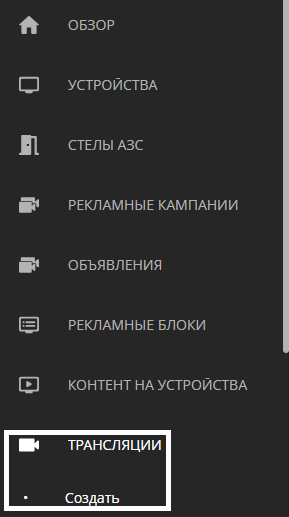
In the personal cabinet, the user needs to find the "Broadcast" section, click on it, and after a pop-up window appears, click on the "Create" line.
After this, the user must select a zone for the broadcast and fill it with content. To be able to work with events in the broadcast, there should be at least two pages.
If there are no events, the broadcast currently defaults to playing by pages, meaning the first page, then the second page, and so on.
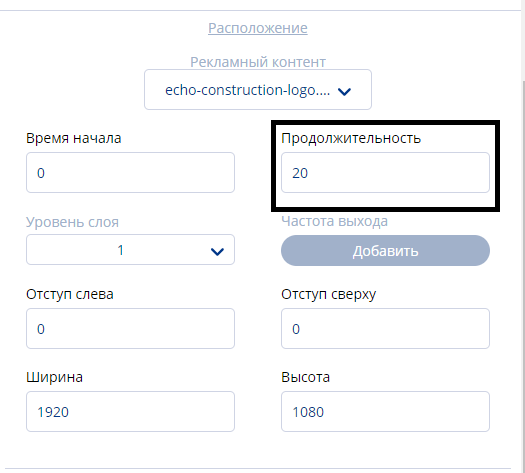
Event Configuration and Types
After adding content to the page, it's necessary to click on the "Page Configuration" icon..
When opening the configuration page, one should move to event creation on the right toolbar.
To do this, click on the "+" icon next to the "Event" line and add an event type.
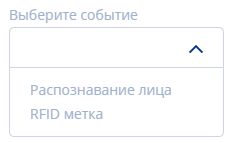
There are two types of events available as triggers:
- RFID tag
It involves two sequentially set parameters: key and value. In the "Key" parameter, a key identifier is selected:
- By payload
- By ID
After choosing one of the two identifiers, a value parameter appears.
In the first case, if the data identifier is set "by ID," these are values that can be found in the device description under "RFID device."
In the second case, if the data identifier is set "by payload," it means the encoded textual meaning. Here, the identifier can take any string value.

- Face Recognition
This also involves two sequentially set parameters: key and value. In the "Key" parameter, a key identifier is selected. In this case, there's only one - by gender. After choosing the identifier, a value parameter appears. The value has two options - male and female. After all settings, it's essential to click the "Save" button.
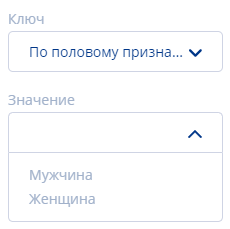
Choosing a Page to Transition to
The page for the transition is chosen in the event creation menu. This parameter is slightly below and is named "Next Page." Inside this parameter, the user selects which page the broadcast will switch to upon triggering the event. After selecting the page, it's also essential to click the "Save" button
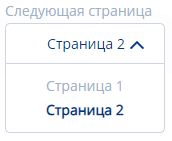
Viewing the Display Scheme and Bindings
You can view the event display scheme and binding lines by clicking on a specific icon. Thanks to this scheme, it's easy to understand whether triggers and events are correctly configured.
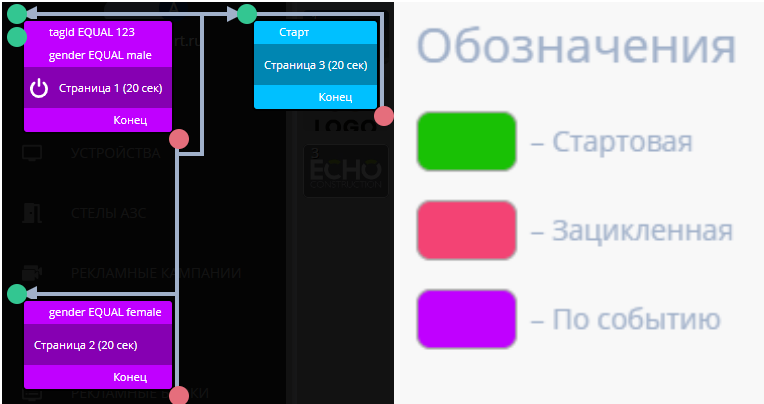
Additional Application Possibilities
The functionality can also interact with devices that have touch solutions embedded. The action algorithm with the touch solution is as follows:
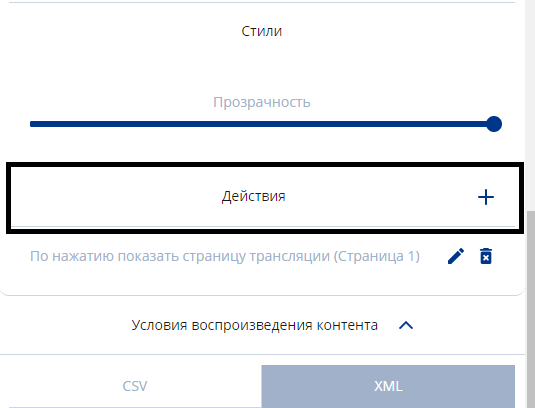
- First, create a broadcast with content to play and content for user pressing. This can be either two different types of content or just one.
- Next, select the content to which you want to attach the "touch" and go to the content settings by clicking on the desired content.
- By clicking the "+" icon next to the action line, the user opens the settings.
- In the window that appears, they need to choose an action. In the "Action" line, "Pressing on the content" is set.
- The next step introduces another line: "Transition to the page". In this line, the user chooses which page the transition will go to.
- Press the "Save" button and finish editing the broadcast.

Final Result
Users know how to use and integrate trigger events into their broadcasts.